+ Open data
Open data
- Basic information
Basic information
| Entry | Database: PDB / ID: 6y53 | ||||||
|---|---|---|---|---|---|---|---|
| Title | human 17S U2 snRNP low resolution part | ||||||
 Components Components |
| ||||||
 Keywords Keywords | SPLICING / 17S U2 snRNP | ||||||
| Function / homology |  Function and homology information Function and homology informationU11/U12 snRNP / U2 snRNP binding / U7 snRNA binding / histone pre-mRNA DCP binding / U7 snRNP / histone pre-mRNA 3'end processing complex / SLBP independent Processing of Histone Pre-mRNAs / SLBP Dependent Processing of Replication-Dependent Histone Pre-mRNAs / B-WICH complex / protein methylation ...U11/U12 snRNP / U2 snRNP binding / U7 snRNA binding / histone pre-mRNA DCP binding / U7 snRNP / histone pre-mRNA 3'end processing complex / SLBP independent Processing of Histone Pre-mRNAs / SLBP Dependent Processing of Replication-Dependent Histone Pre-mRNAs / B-WICH complex / protein methylation / U12-type spliceosomal complex / poly-ADP-D-ribose modification-dependent protein binding / 7-methylguanosine cap hypermethylation / U1 snRNP binding / methylosome / RNA splicing, via transesterification reactions / pICln-Sm protein complex / snRNP binding / chromatin-protein adaptor activity / blastocyst formation / protein localization to site of double-strand break / small nuclear ribonucleoprotein complex / splicing factor binding / SMN-Sm protein complex / spliceosomal tri-snRNP complex / P granule / telomerase holoenzyme complex / U2-type precatalytic spliceosome / commitment complex / mRNA cis splicing, via spliceosome / telomerase RNA binding / U2-type spliceosomal complex / U2-type prespliceosome assembly / U2-type catalytic step 2 spliceosome / RNA Polymerase II Transcription Termination / U2 snRNP / U1 snRNP / U4 snRNP / U2-type prespliceosome / positive regulation of transcription by RNA polymerase III / precatalytic spliceosome / spliceosomal complex assembly / mRNA Splicing - Minor Pathway / mRNA 3'-splice site recognition / positive regulation of transcription by RNA polymerase I / U5 snRNP / U2 snRNA binding / spliceosomal snRNP assembly / U1 snRNA binding / Cajal body / U4/U6 x U5 tri-snRNP complex / catalytic step 2 spliceosome / mRNA Splicing - Major Pathway / Gene and protein expression by JAK-STAT signaling after Interleukin-12 stimulation / RNA splicing / spliceosomal complex / double-strand break repair via homologous recombination / positive regulation of neuron projection development / mRNA splicing, via spliceosome / B-WICH complex positively regulates rRNA expression / fibrillar center / cytoplasmic ribonucleoprotein granule / mRNA processing / site of double-strand break / snRNP Assembly / spermatogenesis / SARS-CoV-2 modulates host translation machinery / RNA helicase activity / nuclear speck / nuclear body / RNA helicase / chromatin remodeling / mRNA binding / nucleolus / enzyme binding / positive regulation of transcription by RNA polymerase II / ATP hydrolysis activity / RNA binding / extracellular exosome / zinc ion binding / nucleoplasm / ATP binding / nucleus / cytoplasm / cytosol Similarity search - Function | ||||||
| Biological species |  Homo sapiens (human) Homo sapiens (human) | ||||||
| Method | ELECTRON MICROSCOPY / single particle reconstruction / cryo EM / Resolution: 7.1 Å | ||||||
 Authors Authors | Zhang, Z. / Will, C.L. / Bertram, K. / Luehrmann, R. / Stark, H. | ||||||
| Funding support |  Germany, 1items Germany, 1items
| ||||||
 Citation Citation |  Journal: Nature / Year: 2020 Journal: Nature / Year: 2020Title: Molecular architecture of the human 17S U2 snRNP. Authors: Zhenwei Zhang / Cindy L Will / Karl Bertram / Olexandr Dybkov / Klaus Hartmuth / Dmitry E Agafonov / Romina Hofele / Henning Urlaub / Berthold Kastner / Reinhard Lührmann / Holger Stark /   Abstract: The U2 small nuclear ribonucleoprotein (snRNP) has an essential role in the selection of the precursor mRNA branch-site adenosine, the nucleophile for the first step of splicing. Stable addition of ...The U2 small nuclear ribonucleoprotein (snRNP) has an essential role in the selection of the precursor mRNA branch-site adenosine, the nucleophile for the first step of splicing. Stable addition of U2 during early spliceosome formation requires the DEAD-box ATPase PRP5. Yeast U2 small nuclear RNA (snRNA) nucleotides that form base pairs with the branch site are initially sequestered in a branchpoint-interacting stem-loop (BSL), but whether the human U2 snRNA folds in a similar manner is unknown. The U2 SF3B1 protein, a common mutational target in haematopoietic cancers, contains a HEAT domain (SF3B1) with an open conformation in isolated SF3b, but a closed conformation in spliceosomes, which is required for stable interaction between U2 and the branch site. Here we report a 3D cryo-electron microscopy structure of the human 17S U2 snRNP at a core resolution of 4.1 Å and combine it with protein crosslinking data to determine the molecular architecture of this snRNP. Our structure reveals that SF3B1 interacts with PRP5 and TAT-SF1, and maintains its open conformation in U2 snRNP, and that U2 snRNA forms a BSL that is sandwiched between PRP5, TAT-SF1 and SF3B1. Thus, substantial remodelling of the BSL and displacement of BSL-interacting proteins must occur to allow formation of the U2-branch-site helix. Our studies provide a structural explanation of why TAT-SF1 must be displaced before the stable addition of U2 to the spliceosome, and identify RNP rearrangements facilitated by PRP5 that are required for stable interaction between U2 and the branch site. | ||||||
| History |
|
- Structure visualization
Structure visualization
| Movie |
 Movie viewer Movie viewer |
|---|---|
| Structure viewer | Molecule:  Molmil Molmil Jmol/JSmol Jmol/JSmol |
- Downloads & links
Downloads & links
- Download
Download
| PDBx/mmCIF format |  6y53.cif.gz 6y53.cif.gz | 474.1 KB | Display |  PDBx/mmCIF format PDBx/mmCIF format |
|---|---|---|---|---|
| PDB format |  pdb6y53.ent.gz pdb6y53.ent.gz | 260.2 KB | Display |  PDB format PDB format |
| PDBx/mmJSON format |  6y53.json.gz 6y53.json.gz | Tree view |  PDBx/mmJSON format PDBx/mmJSON format | |
| Others |  Other downloads Other downloads |
-Validation report
| Summary document |  6y53_validation.pdf.gz 6y53_validation.pdf.gz | 962.7 KB | Display |  wwPDB validaton report wwPDB validaton report |
|---|---|---|---|---|
| Full document |  6y53_full_validation.pdf.gz 6y53_full_validation.pdf.gz | 964.2 KB | Display | |
| Data in XML |  6y53_validation.xml.gz 6y53_validation.xml.gz | 49.2 KB | Display | |
| Data in CIF |  6y53_validation.cif.gz 6y53_validation.cif.gz | 84.1 KB | Display | |
| Arichive directory |  https://data.pdbj.org/pub/pdb/validation_reports/y5/6y53 https://data.pdbj.org/pub/pdb/validation_reports/y5/6y53 ftp://data.pdbj.org/pub/pdb/validation_reports/y5/6y53 ftp://data.pdbj.org/pub/pdb/validation_reports/y5/6y53 | HTTPS FTP |
-Related structure data
| Related structure data |  10689MC  6y50C  6y5qC C: citing same article ( M: map data used to model this data |
|---|---|
| Similar structure data |
- Links
Links
- Assembly
Assembly
| Deposited unit | 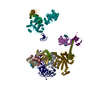
|
|---|---|
| 1 |
|
- Components
Components
-U2 small nuclear ribonucleoprotein ... , 2 types, 2 molecules ab
| #1: Protein | Mass: 28456.584 Da / Num. of mol.: 1 / Source method: isolated from a natural source / Source: (natural)  Homo sapiens (human) / References: UniProt: P09661 Homo sapiens (human) / References: UniProt: P09661 |
|---|---|
| #2: Protein | Mass: 25524.367 Da / Num. of mol.: 1 / Source method: isolated from a natural source / Source: (natural)  Homo sapiens (human) / References: UniProt: P08579 Homo sapiens (human) / References: UniProt: P08579 |
-Splicing factor 3B subunit ... , 4 types, 4 molecules zo8u
| #3: Protein | Mass: 14606.900 Da / Num. of mol.: 1 / Source method: isolated from a natural source / Source: (natural)  Homo sapiens (human) / References: UniProt: Q9Y3B4 Homo sapiens (human) / References: UniProt: Q9Y3B4 |
|---|---|
| #8: Protein | Mass: 44436.570 Da / Num. of mol.: 1 / Source method: isolated from a natural source / Source: (natural)  Homo sapiens (human) / References: UniProt: Q15427 Homo sapiens (human) / References: UniProt: Q15427 |
| #17: Protein | Mass: 100377.812 Da / Num. of mol.: 1 / Source method: isolated from a natural source / Source: (natural)  Homo sapiens (human) / References: UniProt: Q13435 Homo sapiens (human) / References: UniProt: Q13435 |
| #18: Protein | Mass: 146024.938 Da / Num. of mol.: 1 / Source method: isolated from a natural source / Source: (natural)  Homo sapiens (human) / References: UniProt: O75533 Homo sapiens (human) / References: UniProt: O75533 |
-Protein , 3 types, 3 molecules pmq
| #4: Protein | Mass: 117576.484 Da / Num. of mol.: 1 / Source method: isolated from a natural source / Source: (natural)  Homo sapiens (human) / References: UniProt: Q7L014, RNA helicase Homo sapiens (human) / References: UniProt: Q7L014, RNA helicase |
|---|---|
| #9: Protein | Mass: 24642.131 Da / Num. of mol.: 1 / Source method: isolated from a natural source / Source: (natural)  Homo sapiens (human) / References: UniProt: P14678 Homo sapiens (human) / References: UniProt: P14678 |
| #16: Protein | Mass: 85965.961 Da / Num. of mol.: 1 / Source method: isolated from a natural source / Source: (natural)  Homo sapiens (human) / References: UniProt: O43719 Homo sapiens (human) / References: UniProt: O43719 |
-Splicing factor 3A subunit ... , 3 types, 3 molecules 679
| #5: Protein | Mass: 88991.094 Da / Num. of mol.: 1 / Source method: isolated from a natural source / Source: (natural)  Homo sapiens (human) / References: UniProt: Q15459 Homo sapiens (human) / References: UniProt: Q15459 |
|---|---|
| #6: Protein | Mass: 49327.355 Da / Num. of mol.: 1 / Source method: isolated from a natural source / Source: (natural)  Homo sapiens (human) / References: UniProt: Q15428 Homo sapiens (human) / References: UniProt: Q15428 |
| #7: Protein | Mass: 58934.844 Da / Num. of mol.: 1 / Source method: isolated from a natural source / Source: (natural)  Homo sapiens (human) / References: UniProt: Q12874 Homo sapiens (human) / References: UniProt: Q12874 |
-Small nuclear ribonucleoprotein ... , 6 types, 6 molecules knhlji
| #10: Protein | Mass: 8508.084 Da / Num. of mol.: 1 / Source method: isolated from a natural source / Source: (natural)  Homo sapiens (human) / References: UniProt: P62308 Homo sapiens (human) / References: UniProt: P62308 |
|---|---|
| #11: Protein | Mass: 13310.653 Da / Num. of mol.: 1 / Source method: isolated from a natural source / Source: (natural)  Homo sapiens (human) / References: UniProt: P62314 Homo sapiens (human) / References: UniProt: P62314 |
| #12: Protein | Mass: 13551.928 Da / Num. of mol.: 1 / Source method: isolated from a natural source / Source: (natural)  Homo sapiens (human) / References: UniProt: P62316 Homo sapiens (human) / References: UniProt: P62316 |
| #13: Protein | Mass: 13940.308 Da / Num. of mol.: 1 / Source method: isolated from a natural source / Source: (natural)  Homo sapiens (human) / References: UniProt: P62318 Homo sapiens (human) / References: UniProt: P62318 |
| #14: Protein | Mass: 10817.601 Da / Num. of mol.: 1 / Source method: isolated from a natural source / Source: (natural)  Homo sapiens (human) / References: UniProt: P62304 Homo sapiens (human) / References: UniProt: P62304 |
| #15: Protein | Mass: 9734.171 Da / Num. of mol.: 1 / Source method: isolated from a natural source / Source: (natural)  Homo sapiens (human) / References: UniProt: P62306 Homo sapiens (human) / References: UniProt: P62306 |
-RNA chain , 1 types, 1 molecules 2
| #19: RNA chain | Mass: 60186.445 Da / Num. of mol.: 1 / Source method: isolated from a natural source / Source: (natural)  Homo sapiens (human) / References: GenBank: 36516 Homo sapiens (human) / References: GenBank: 36516 |
|---|
-Experimental details
-Experiment
| Experiment | Method: ELECTRON MICROSCOPY |
|---|---|
| EM experiment | Aggregation state: PARTICLE / 3D reconstruction method: single particle reconstruction |
- Sample preparation
Sample preparation
| Component | Name: human 17S U2 snRNP / Type: COMPLEX / Entity ID: all / Source: NATURAL |
|---|---|
| Source (natural) | Organism:  Homo sapiens (human) Homo sapiens (human) |
| Buffer solution | pH: 7.9 |
| Specimen | Embedding applied: NO / Shadowing applied: NO / Staining applied: NO / Vitrification applied: YES |
| Specimen support | Grid material: COPPER / Grid type: Quantifoil R3.5/1 |
| Vitrification | Instrument: FEI VITROBOT MARK I / Cryogen name: ETHANE / Humidity: 100 % / Chamber temperature: 277 K |
- Electron microscopy imaging
Electron microscopy imaging
| Experimental equipment |  Model: Titan Krios / Image courtesy: FEI Company |
|---|---|
| Microscopy | Model: FEI TITAN KRIOS |
| Electron gun | Electron source:  FIELD EMISSION GUN / Accelerating voltage: 300 kV / Illumination mode: SPOT SCAN FIELD EMISSION GUN / Accelerating voltage: 300 kV / Illumination mode: SPOT SCAN |
| Electron lens | Mode: BRIGHT FIELD / Cs: 0.01 mm / Alignment procedure: ZEMLIN TABLEAU |
| Specimen holder | Cryogen: NITROGEN / Specimen holder model: FEI TITAN KRIOS AUTOGRID HOLDER |
| Image recording | Average exposure time: 1 sec. / Electron dose: 72 e/Å2 / Detector mode: INTEGRATING / Film or detector model: FEI FALCON III (4k x 4k) |
- Processing
Processing
| EM software |
| ||||||||||||||||||||
|---|---|---|---|---|---|---|---|---|---|---|---|---|---|---|---|---|---|---|---|---|---|
| CTF correction | Type: PHASE FLIPPING AND AMPLITUDE CORRECTION | ||||||||||||||||||||
| 3D reconstruction | Resolution: 7.1 Å / Resolution method: FSC 0.143 CUT-OFF / Num. of particles: 120070 / Symmetry type: POINT | ||||||||||||||||||||
| Atomic model building | Space: REAL |
 Movie
Movie Controller
Controller






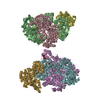
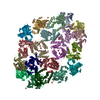
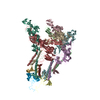
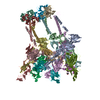
 PDBj
PDBj








































